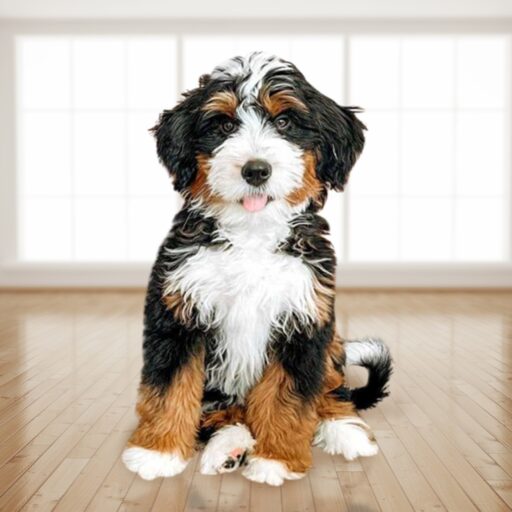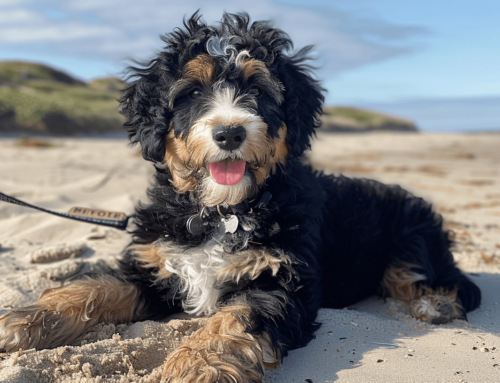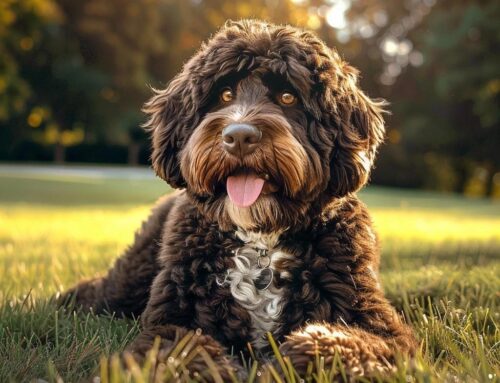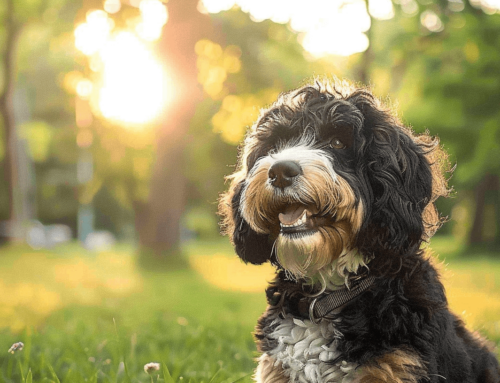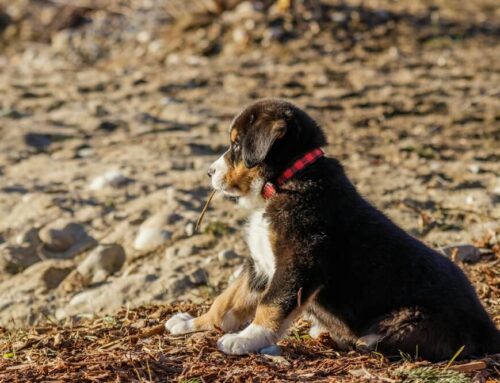You walk into your home after a long day’s work. As you step in the door, you’re attacked — but in a good way. Your dog runs out, so excited that anyone would swear you’ve been gone for a month instead of just eight hours. Nothing beats the unconditional love and companionship of your canine pal.
Now picture this: You walk in the door and get attacked — but this time by your own sneezing, coughing and teary eyes.
Dog allergies are a nuisance, and often a serious one. And if you’re an allergy sufferer and dog lover, your allergy can diminish your enjoyment of your dog.
With the prevalence of designer dogs, you may wonder whether it’s possible to get a completely hypoallergenic breed. The good news is many hybrid dogs are hypoallergenic dog breeds.
Table of Contents
What Are Hypoallergenic Dogs?
Hypoallergenic means something is less likely to cause an allergic reaction.
For example, hypoallergenic facial cleanser probably won’t cause a breakout even on sensitive skin. Similarly, even if you’re allergic to dogs, you’re less likely to have an allergic reaction if you have a hypoallergenic dog breed.
Pet hair indirectly affects allergies. Curly-haired dogs are normally hypoallergenic — they shed when brushed, but not during normal daily activities.
The Difference Between Allergy-Friendly and Hypoallergenic
Some people mistakenly believe hypoallergenic means 100% protection from an allergic reaction. But it actually means you’re not as likely to get allergic reactions.
When a dog is called hypoallergenic, that’s another way of saying the dog is allergy-friendly. Some dogs, like the standard poodle, are well-known for being less likely to cause an allergic reaction.
Whether you want a mixed dog breed, a doodle dog or one of the other designer dog breeds, if you have allergies, you should also consider whether the dog breed is hypoallergenic.
Is a Bernedoodle Hypoallergenic?
You’ve weighed the pros and cons of both purebred dogs and mixed breeds. You’ve narrowed your preferences and decided you love the coloring of a Bernese mountain dog but want the size of the miniature poodle. Then you see pictures of adorable bernedoodle puppies and realize you can have the best of both breeds.
But a question remains: “Are bernedoodles hypoallergenic?”
The answer is yes. A bernedoodle (also called a Bernese mountain poo) can be one of the best hypoallergenic dogs.
Its hypoallergenic qualities depend on the percentage of poodle in the hybrid. Obviously, the poodle’s curly coat is produced by the poodle genes, not the Bernese mountain dog gene. More poodle in the mix produces a more hypoallergenic bernedoodle.
This applies whether the individual dog is a standard bernedoodle or one of the smaller miniature or tiny breeds.
If the percentage of poodle is higher than the percentage of Bernese mountain dog, you probably won’t have an allergic reaction. Just remember: Curly coats equal less shedding.
Keep reading for five things you need to know about allergies and bernedoodles.
Why Am I Allergic to Dogs?
If you have a dog allergy, you’re not alone. According to the National Institutes of Health, between 10% and 20% of adults are allergic to dogs.
Dog hair or dog dander is typically blamed for allergies, but that’s not the full picture. Hair and dander do, however, contribute to the process that leads to the allergic reaction.
Dog saliva contains a protein that our immune system identifies as foreign. When dogs lick themselves, their saliva transfers this protein to their skin. They shed hair and with it, microscopic flecks of skin called dander (like dandruff in humans). Protein from their saliva is on that pet dander.
If you’re allergic to dogs and encounter that dander in the air, your immune system reacts, and you start sneezing.
Do Bernedoodles Shed?
A low-shedding dog produces less of the allergen that triggers pet allergies. Getting a dog that doesn’t shed can help you avoid allergic reactions. Bernedoodles are one of the hybrid dog breeds that are known as low-shedding or non-shedding.
The Bernedoodle’s shedding depends on its pet parents — i.e., whether it inherits more from its poodle parent or from its Bernese mountain dog parent.
The main factor in low shedding is the inherited curly poodle coat.
How Do Parent Breeds Affect Shedding?
The amount a bernedoodle shed depends on the percentage of poodle versus Bernese mountain dog in its parentage.
If you’re allergic to dogs, avoid the F1 generation of bernedoodles, which is a 50/50 mix of poodle and Bernese mountain dog. With just 50% poodle parentage, the F1 bernedoodle’s hair, like many other dog breeds, may not be curly enough to catch shed hair.
Similarly, F2 bernedoodles, which are two F1s bred together, are not the best option for allergy sufferers.
Instead, if you suffer from allergies, opt for F1b bernedoodle, which is 75% poodle and 25% Bernese mountain dog. Because of the higher percentage of poodle in this generation, the F1b bernedoodle won’t shed as much as F1 bernedoodle.
Another option is the F2b generation, a cross-breed between an F1 bernedoodle (50/50) and an F1b (75/25). This produces a 62.5 % poodle/37.5% Bernese mountain dog Bernedoodle. F2bs are non-shedding or low-shedding dogs.
What Are the Grooming Requirements for Bernedoodles?
Now that you have a low- or non-shedding bernedoodle, you won’t have to worry so much about grooming, right? Wrong. A common misconception is that hypoallergenic dogs don’t shed hair at all.
We’ve already established that curly-haired dogs are low-shedding. That’s because when hair detaches from the dog’s body, it gets trapped in its curls rather than shedding on your couch. Regular brushing releases that loose hair from your bernedoodle’s coat.
A regular grooming routine of either daily brushing for a couple of minutes or longer brushing twice a week helps prevent matting and keeps the coat healthy.
Besides a brushing routine, grooming appointments every couple of months will keep your bernedoodle’s coat in good shape.
A Breakdown of a Bernedoodle’s Coat
A bernedoodle can have a wavy fleece coat, a curly wool coat (like a sheep’s) or straight hair. The wool and fleece coats are hypoallergenic.
A hair coat, on the other hand, is the typical straight coat you see on many dogs. These shed easily, so those who need a hypoallergenic bernedoodle should avoid the ones with a hair coat.
The curlier the coat, the more hypoallergenic the dog. If you’re allergic to dogs, a curly-coated bernedoodle is the best choice.
What Else Can I Do to Help With Allergies From My Dog?
The main cause of most dog allergies is a protein in their saliva that gets on dander and then on you. This can also happen when your dog licks you. While it seems almost impossible to turn down a kiss from a bernedoodle puppy, to reduce the chance of an allergic reaction, give your pup a hug instead.
Also, invest in an air filter. It helps reduce the microscopic dander in the atmosphere, decreasing your chance of an allergic reaction.
If these steps aren’t enough, though, you may want to see an allergist. A trained expert can often help when other methods fail.
Reserve Your Hypoallergenic Bernedoodle Today
Have you been considering getting a cuddly bernedoodle? If so, why wait? Central Illinois Doodles has helped many experienced dog lovers and first-time dog owners find the perfect puppy, and we’d love to help you, too. Reach us today by completing our contact form or calling t to start the process of finding the dog breed that best suits you.
